Topic: Tides
Tides
The graph below shows changing ocean tide heights in feet (ft) on April 7 for a coastal location.
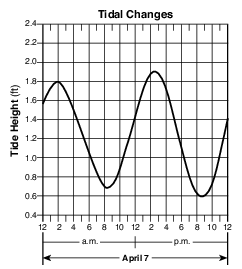
The next high tide will occur on April 8 at approximately
(1) 10 a.m.
(2) 10 p.m.
(3) 3 a.m.
(4) 3 p.m.
Approximately which percentage of Earth’s surface is exposed above water?
(1) 30%
(2) 50%
(3) 70%
(4) 90%

The highest high tides and the lowest low tides occurred when the Moon was near
(1) apogee and a new-Moon phase
(2) apogee and a full-Moon phase
(3) perigee and a new-Moon phase
(4) perigee and a full-Moon phase
The diagram below represents eight positions of the Moon in its orbit.

Why are high tides on Earth greatest when the Moon is in position A and in position E?
(1) The Moon is closer to the Sun.
(2) The Moon is closer to Earth.
(3) The Moon, the Sun, and Earth are aligned.
(4) The Moon is in the same phase at both locations.
The hydrosphere covers approximately what percentage of Earth’s lithosphere?
(1) 100%
(2) 70%
(3) 50%
(4) 25%
The frequency of Earth’s cycle of ocean tides is primarily controlled by
(1) Earth’s rotation and the Moon’s rotation
(2) Earth’s rotation and the Moon’s revolution
(3) Earth’s revolution and the Moon’s rotation
(4) Earth’s revolution and the Moon’s revolution
The graph below shows the change in the heights of tides for two days.

If this pattern continues, during the first six hours on Wednesday, tidal height will
(1) decrease, only
(2) decrease, then increase
(3) increase, only
(4) increase, then decrease
The graph below shows the tidal changes in ocean water level, in meters, recorded at a coastal location on a certain day.

Approximately how many hours apart were the two high tides?
(1) 6 h
(2) 12 h
(3) 18 h
(4) 24 h
Ocean tides observed at coastal locations each day are primarily caused by
(1) Earth’s revolution around the Sun
(2) the changing phases of the Moon
(3) the gravitational attraction between the Moon and Earth
(4) seasonal changes in the compass location of sunrise
The graph below shows ocean water levels for a shoreline location on Long Island, New York. The graph also indicates the dates and times of high and low tides.

Based on the data, the next high tide occurred at approximately
(1) 4 p.m. on July 13
(2) 10 p.m. on July 13
(3) 4 p.m. on July 14
(4) 10 p.m. on July 14
Explain why the Moon’s gravity has a greater effect on Earth’s ocean tides than the Sun’s gravity. [1]
Allow 1 credit. Acceptable responses include, but are not limited to:
• — The Moon is closer to Earth so gravity is greater.
• — The Sun is much farther away.
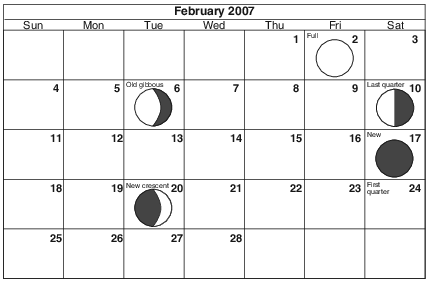
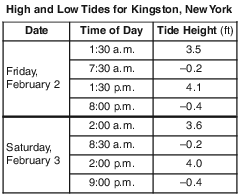
On the grid in the image provided, plot the tide height for each time of day listed in the data table. Connect the plots with a line. [1]

Allow 1 credit if the centers of all eight plots are located within the circles shown below and are connected with a line that passes within each circle.
• Note: It is recommended that an overlay of the same scale as the student answer booklet be used
• to ensure reliability in rating.
• 
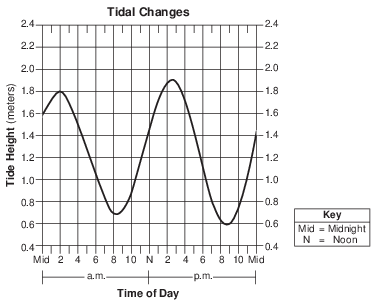
Determine the tide height and time of day for the lowest tide shown on the graph. Include a.m. or p.m. in your answer for the time of day. [1]
Tide height:
Time:
Allow 1 credit if both the tide height and time of day, including p.m., are correct.
• Tide height: any value from 0.58 m to 0.6 m.
• Time: any value from 8:30 p.m. to 9:00 p.m.

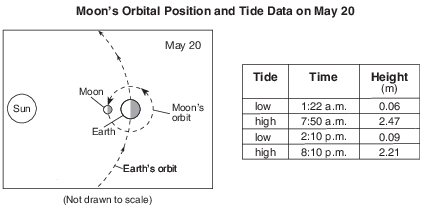
Determine the length of time between the two high tides shown for May 13. [1]
____________ h ____________ min
Allow 1 credit for 12 h 33 min.
On the diagram in the image provided, draw an X to represent the solar noon position of the Sun as seen by the observer on April 21. [1]

Allow 1 credit if the center of the X is within or touches the boxed area shown below.
• Note: It is recommended that an overlay of the same scale as the student answer booklet be used
• to ensure reliability in rating.
• 
